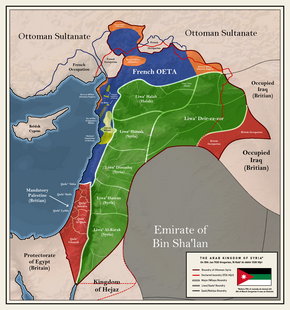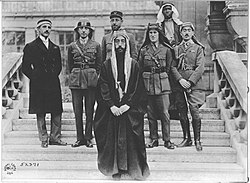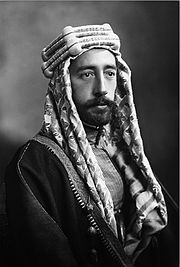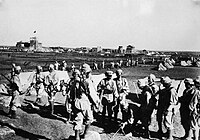Arab Kingdom of Syria
Topic: History
 From HandWiki - Reading time: 8 min
From HandWiki - Reading time: 8 min
Arab Kingdom of Syria | |||||||||||||||
|---|---|---|---|---|---|---|---|---|---|---|---|---|---|---|---|
| 1919–1920 | |||||||||||||||
Anthem: سوريا يا ذات المجد O Syria, Who Owns the Glory[1] | |||||||||||||||
 The Arab Kingdom of Syria at its greatest extent in January 1920 | |||||||||||||||
| Capital | Damascus Lua error in package.lua at line 80: module 'strict' not found. | ||||||||||||||
| Common languages | Arabic | ||||||||||||||
| Demonym(s) | Syrian | ||||||||||||||
| Government | Unitary parliamentary constitutional monarchy | ||||||||||||||
| King | |||||||||||||||
• 1920 | Faisal I | ||||||||||||||
| Prime Minister | |||||||||||||||
• 1920 (first) | Rida Pasha al-Rikabi | ||||||||||||||
• 1920 (last) | Hashim al-Atassi | ||||||||||||||
| Legislature | National Congress | ||||||||||||||
| Historical era | Interwar period | ||||||||||||||
• British withdrawal | 26 November 1919 | ||||||||||||||
• Coronation of Faisal I | 8 March 1920 | ||||||||||||||
• Battle of Maysalun | 24 July 1920 | ||||||||||||||
• Siege of Damascus | 25 July 1920 | ||||||||||||||
| Currency | Syrian pound | ||||||||||||||
| |||||||||||||||
The Arab Kingdom of Syria (Arabic: المملكة العربية السورية, al-Mamlakah al-‘Arabīyah as-Sūrīyah) was a self-proclaimed, unrecognized constitutional monarchy existing briefly in the territory of historical Syria. It was announced on 5 October 1918 as a fully independent Arab constitutional government with the permission of the British military.[2] It gained de facto independence as an Emirate after the withdrawal of the British forces from OETA East on 26 November 1919,[3] and was proclaimed as a Kingdom on 8 March 1920.
As a Kingdom it existed only a little over four months, from 8 March to 25 July 1920.[4][5] During its brief existence, the kingdom was led by Sharif Hussein bin Ali's son Faisal bin Hussein. Despite its claims to the territory of the Levant, Faisal's government controlled a limited area and was dependent on Britain which, along with France, generally opposed the idea of a Greater Syria and refused to recognize the kingdom.[6] The kingdom surrendered to French forces on 25 July 1920.
History
Foundations
The Arab Revolt and the McMahon–Hussein Correspondence were crucial factors in the foundation of the Arab Kingdom of Syria. In the McMahon–Hussein Correspondence promises of an Arab Kingdom were made by the British in return for an Arab uprising against the Ottomans.[2]:209–215 As the British were promising independence, The French made the Sykes–Picot Agreement. Ultimately, the implementation of the Sykes–Picot Agreement would lead to the undermining and end of the Arab Kingdom of Syria. Despite the significance of the Arab Revolt to modern Arab countries formed in its wake, at the time there was significant distrust and even opposition to the idea of an Arab Kingdom or series of Arab Kingdoms.
This opposition was due in part to the heavy influence of the French and the British in facilitating the revolt and the establishment of what would be considered, by modern standards, puppet states.[7]:185–191 The involvement of foreign powers in distributing large sums of money and military support to establish an empire that would be led by imperial aspirants, rather than legitimate Arab nationalists, was instrumental in the disintegration of the majority of the early Hashemite Kingdoms (Kingdom of Hejaz and Kingdom of Iraq). Additionally, at the time, many Arabs expressed grave concerns that the family of the Sharif of Mecca, the Hashemites, could wrest control from the Ottoman Sultan, with whom their loyalty had rested for centuries.[7]:187
Arab constitutional government
Near the end of World War I, the British Egyptian Expeditionary Force, under command of Edmund Allenby, captured Damascus on 30 September 1918. Shortly thereafter, on 3 October, Faisal entered the city.[2]:30[8] The jubilation would be short lived, as Faisal would soon be made aware of the Sykes–Picot agreement. Faisal had come to expect an independent Arab kingdom in the name of his father but was soon told of the division of territory and how Syria fell under French protective power. Faisal saw this admission as a betrayal by the British, but believed the actual settlement would be worked out at a later date when the war had ended. There was some likelihood that by then the British would have changed their support for French pretensions in Syria.
On 5 October, with the permission of General Allenby, Faisal announced the establishment of a fully and absolutely independent Arab constitutional government.[2]:34 Faisal announced it would be an Arab government based on justice and equality for all Arabs regardless of religion.[9] The French Prime Minister Georges Clemenceau found disconcerting the establishment of a semi-independent Arab state without international recognition and under the auspices of the British. Even reassurances by Allenby that all actions taken were provisional did not ease the looming tensions between the British, the French, and the Arabs. For Arab nationalists, and many of the Arabs who fought in the Arab Revolt, this independent state would be the realization of a long hard-fought goal.
Determining the status
After the war, at the Paris Peace Conference of 1919, Faisal pushed for Arab independence. At the Conference, the victorious Allies decided what was to become of the defeated nations of the Central Powers, especially who was to control their territories, such as the Ottoman Empire's Middle East possessions. The status of the Arab lands in the Middle East was the subject of intense negotiations between the French and British. In May 1919, the French and British prime ministers met in Quai d’Orsay to decide between them their respective claims to territories or spheres of influence in the Middle East. The meeting determined that in return for a British guarantee of French control in Syria, the British would be given a mandate over Mosul and Palestine.
At about the same time, an American compromise resulted in an agreement to set up a commission to determine the wishes of the inhabitants. Though they initially supported the idea, Britain and France eventually backed out, leaving the King–Crane Commission of 1919 solely American.[7]:268 The findings of the commission, not published until 1922 after the vote on the mandates in the League of Nations, indicated strong Arab support for an independent Arab state and opposition to a French presence.[10]
Creation

These events in Europe led Syrian nationalist societies like al-Fatat (the Young Arab Society) to make preparations for a national congress. These Syrian nationalist societies advocated complete independence for an Arab Kingdom that united Arabs under Faisal. The King–Crane Commission encouraged efforts to unify, and hasty elections were called including representatives from all over the Arab lands, including Palestine and Lebanon, although French officials prevented many of their representatives from arriving.[11] The first official session of the Syrian Congress was held on 3 June 1919 and al-Fatat member Hashim al-Atassi was elected its president.[12]:17
When the King–Crane Commission arrived in Damascus on 25 June 1919, it was met with a flurry of leaflets saying "Independence or Death".
On 2 July the Syrian National Congress in Damascus passed the Damascus Program, a series of resolutions calling for a completely independent constitutional monarchy with Faisal as king, asking for assistance from the United States, and rejecting any rights claimed by the French.[12]:19 The resolutions defined the borders as
on the north, the Taurus Range; on the south, a line running from Rafah to Al-Jauf and following the Syria-Hejaz border below 'Aqaba; on the east, the boundary formed by the Euphrates and Khabur rivers and a line stretching from some distance east of Abu-Kamal to some distance east of al-Jauf; on the west, the Mediterranean Sea.[13]
Any hope that Faisal may have had that either the British or Americans would come to his aid and counter French moves quickly faded, especially after the Anglo-French Agreement for the withdrawal of British troops from Syria and the end of the British military government in Syria. The British withdrew from the region on 26 November 1919.[3]
In January 1920, Faisal was forced into an agreement with France which stipulated that France would uphold the existence of the Syrian state and would not station troops in Syria as long as the French government remained the only government supplying advisers, counselors and technical experts.[14]:167 News of this compromise did not bode well with Faisal's vehemently anti-French and independence-minded supporters who immediately pressured Faisal to reverse his commitment, which he did. In the aftermath of this reversal, violent attacks against French forces took place and the Syrian Congress assembled in March 1920 to declare Faisal the king of Syria as well as to officially set up the Arab Kingdom of Syria with Hashim al-Atassi as Prime Minister and Yusuf al-'Azma as Minister of War and Chief of Staff.
This unilateral action was immediately repudiated by the British and French and the San Remo Conference was called by the Allied Powers in April 1920 to finalise the allocation of League of Nations mandates in the Middle East. This was in turn repudiated by Faisal and his supporters. After months of instability and failure to make good on the promises to the French, the commander of French forces General Henri Gouraud gave an ultimatum to King Faisal on 14 July 1920 declaring he surrender or fight.[12]:215
Dissolution
Worried about the results of a long bloody fight with the French, King Faisal surrendered. However, Yusuf al-'Azma, the defense minister, ignored the King's order, and led a small army to confront the French advance into Syria. This army depended mainly on individual weapons and were no match to the French artillery. At the Battle of Maysalun, the Syrian army was easily defeated by the French, with General al-'Azma being killed during the battle. The loss led to the siege and capture of Damascus on 24 July 1920 and the French Mandate for Syria and the Lebanon was put into effect thereafter.
Legacy
After surrendering to French forces, Faisal was expelled from Syria and went to live in the United Kingdom in August 1920. In August 1921 he was offered the crown of Iraq under the British Mandate of Iraq.
A pro-French government under the leadership of Aladdin Al-Droubi was installed one day after the fall of Damascus, on 25 July 1920.[12]:37 On 1 September 1920, General Gouraud divided the French mandate territory of Syria into several smaller states as part of a French scheme to make Syria easier to control.
The Kingdom, through its short and tumultuous existence, would become a subject of great inspiration to later Arab liberation movements. It would be the often-repeated story of an Arab people breaking out from their colonial bonds only to be castigated for their revolutionary fervor and for their resistance to the imperial powers. The symbolism of the fall of the Kingdom of Syria also imparted deep mistrust of European powers, who were seen as liars and oppressors.
Politics of Syria (1918–1920)
Heads of Government
| Name | Term Start | Term end | Political Party |
|---|---|---|---|
| Muhammad Said al-Jazairi | 30 September 1918 | 30 September 1918 | |
| Ali Rida Pasha al-Rikabi | 30 September 1918 | 5 October 1918 | |
| Emir Faisal | 5 October 1918 | 8 March 1920 |
King
| Name | Reign Start | Reign end |
|---|---|---|
| Faisal I | 8 March 1920 | 28 July 1920 |
Prime Ministers
| Name | Term Start | Term end | Political Party |
|---|---|---|---|
| Ali Rida Pasha al-Rikabi | 8 March 1920 | 3 May 1920 | |
| Hashim al-Atassi | 3 May 1920 | 28 July 1920 |
Gallery
French drawing celebrating the capture of Damascus in 1920
References
- ↑ "Kingdom of Syria (1920) Patriotic Song "O'Syria who owns the glory"". https://www.youtube.com/watch?v=YmLgvHAJ_FA.
- ↑ 2.0 2.1 2.2 2.3 Zeine N. Zeine. Struggle for Arab Independence: Western Diplomacy and the Rise and Fall of Faisal's Kingdom in Syria. Caravan Books. Delmar, New York. 1977.
- ↑ 3.0 3.1 Tauber, Eliezer (13 September 2013). The Formation of Modern Iraq and Syria. Routledge. pp. 30–. ISBN 978-1-135-20118-0. https://books.google.com/books?id=RvXZAAAAQBAJ&pg=PA30.
- ↑ Kuhn, Anthony John (15 April 2011). "Broken Promises:The French Expulsion of Emir Feisal and the Failed Struggle for Syrian Independence". Carnegie Mellon University/H&SS Senior Honors Thesis: 60. http://repository.cmu.edu/cgi/viewcontent.cgi?article=1125&context=hsshonors. Retrieved 21 March 2018.
- ↑ Antonius, George (1938). The Arab Awakening: The Story of the Arab National Movement (Reprint ed.). H. Hamilton. p. 104. ISBN 1626540861. https://books.google.com/books?id=ImJtAAAAMAAJ&q=March+8. Retrieved 2020-06-02.
- ↑ Itamar Rabinovich, Symposium: The Greater-Syria Plan and the Palestine Problem in The Jerusalem Cathedra (1982), p. 262.
- ↑ 7.0 7.1 7.2 Efraim Karsh and Inari Karsh. Empires of the Sand: The Struggle for Mastery in the Middle East 1789–1923. Harvard University Press. Cambridge, Massachusetts. 1999.
- ↑ John D. Grainger (2013). The Battle for Syria, 1918–1920. Boydell Press. ISBN 978-1-84383-803-6. https://books.google.com/books?id=LG2cG5SshpEC. Retrieved 2017-12-07.
- ↑ Ali A. Allawi (11 March 2014). Faisal I of Iraq. Yale University Press. pp. 154–. ISBN 978-0-300-19936-9. https://books.google.com/books?id=xCLBAgAAQBAJ&pg=PA154. Retrieved 7 December 2017.
- ↑ US Dept of State; International Boundary Study, Jordan – Syria Boundary, No. 94 – December 30, 1969, Pg .10 "Archived copy". http://www.law.fsu.edu/library/collection/LimitsinSeas/IBS094.pdf.
- ↑ Rogan, Eugene (2012). The Arabs A History (3rd ed.). New York: Basic Books. ISBN 9780465032488. https://books.google.com/books?id=16U0mEbf4nAC&q=the+King%E2%80%93Crane+Commission+french+prevented&pg=PT266. Retrieved 2020-12-06.
- ↑ 12.0 12.1 12.2 12.3 Eliezer Tauber. The Formation of Modern Syria and Iraq. Frank Cass and Co. Ltd. Portland, Oregon. 1995. ISBN:978-0-7146-4105-8.
- ↑ Antonius 1938, p. 439, appendix G.
- ↑ Elie Kedourie. England and the Middle East: The Destruction of the Ottoman Empire 1914–1921. Mansell Publishing Limited. London, England. 1987.
 |
 KSF
KSF









